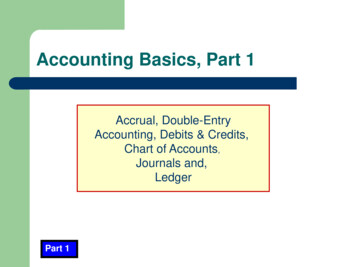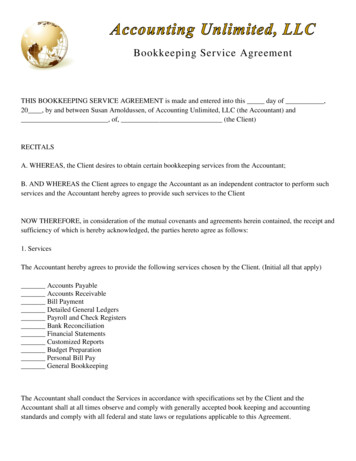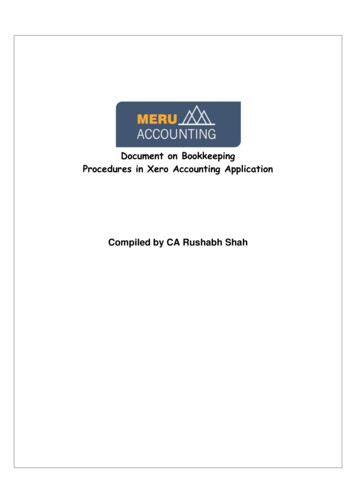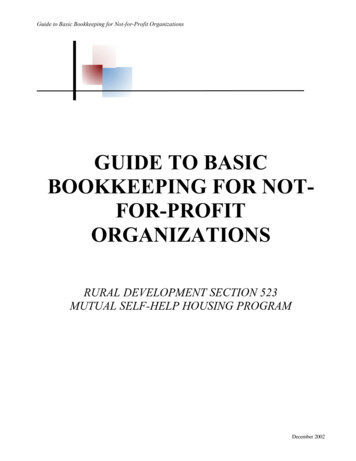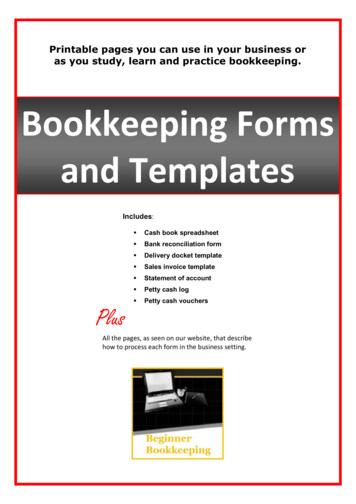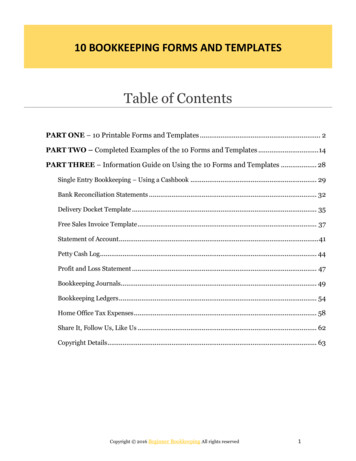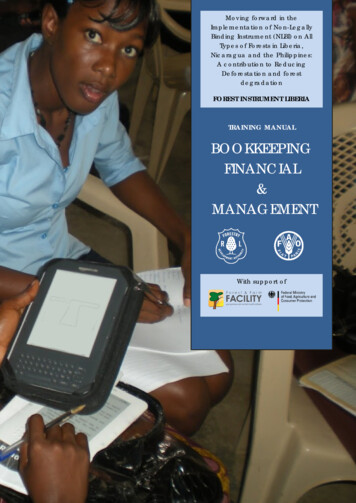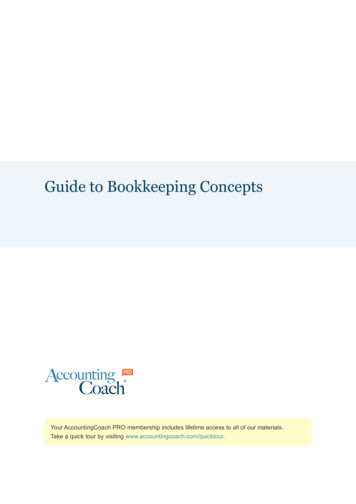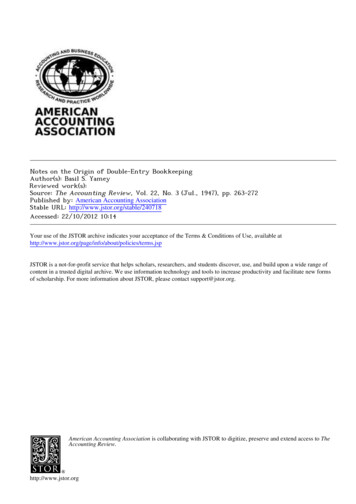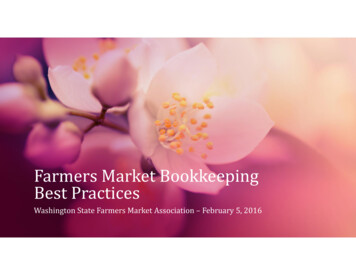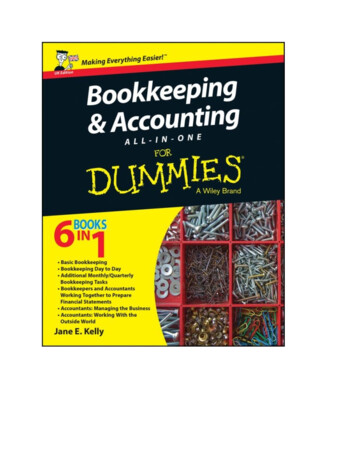
Transcription
Bookkeeping & Accounting All-in-One For Dummies Published by: John Wiley & Sons, Ltd., The Atrium, Southern Gate,Chichester, www.wiley.comThis edition first published 2015 2015 John Wiley & Sons, Ltd, Chichester, West Sussex.Registered officeJohn Wiley & Sons Ltd, The Atrium, Southern Gate, Chichester, WestSussex, PO19 8SQ, United KingdomFor details of our global editorial offices, for customer services and forinformation about how to apply for permission to reuse the copyright materialin this book please see our website at www.wiley.com.All rights reserved. No part of this publication may be reproduced, stored in aretrieval system, or transmitted, in any form or by any means, electronic,mechanical, photocopying, recording or otherwise, except as permitted by theUK Copyright, Designs and Patents Act 1988, without the prior permission ofthe publisher.Wiley publishes in a variety of print and electronic formats and by print-ondemand. Some material included with standard print versions of this bookmay not be included in e-books or in print-on-demand. If this book refers tomedia such as a CD or DVD that is not included in the version youpurchased, you may download this material at www.dummies.com. For moreinformation about Wiley products, visit www.wiley.com.Designations used by companies to distinguish their products are oftenclaimed as trademarks. All brand names and product names used in this bookare trade names, service marks, trademarks or registered trademarks of theirrespective owners. The publisher is not associated with any product or vendormentioned in this book.LIMIT OF LIABILITY/DISCLAIMER OF WARRANTY: WHILETHE PUBLISHER AND AUTHOR HAVE USED THEIR BESTEFFORTS IN PREPARING THIS BOOK, THEY MAKE NOREPRESENTATIONS OR WARRANTIES WITH THE RESPECT TOTHE ACCURACY OR COMPLETENESS OF THE CONTENTS OFTHIS BOOK AND SPECIFICALLY DISCLAIM ANY IMPLIED
WARRANTIES OF MERCHANTABILITY OR FITNESS FOR APARTICULAR PURPOSE. IT IS SOLD ON THE UNDERSTANDINGTHAT THE PUBLISHER IS NOT ENGAGED IN RENDERINGPROFESSIONAL SERVICES AND NEITHER THE PUBLISHERNOR THE AUTHOR SHALL BE LIABLE FOR DAMAGES ARISINGHEREFROM. IF PROFESSIONAL ADVICE OR OTHER EXPERTASSISTANCE IS REQUIRED, THE SERVICES OF A COMPETENTPROFESSIONAL SHOULD BE SOUGHT.For general information on our other products and services, please contactour Customer Care Department within the U.S. at 877-762-2974, outside theU.S. at (001) 317-572-3993, or fax 317-572-4002. For technical support,please visit www.wiley.com/techsupport.For technical support, please visit www.wiley.com/techsupport.A catalogue record for this book is available from the British Library.ISBN 978-1-119-02653-2 (paperback); ISBN 978-1-119-02660-0 (ebk);ISBN 978-1-119-02661-7 (ebk)
Bookkeeping & Accounting All-inOne For Dummies ingaioto view this book's cheat sheet.Table of ContentsCoverIntroductionAbout This BookFoolish AssumptionsIcons Used in This BookBeyond the BookWhere to Go from HereBook I: Basic BookkeepingChapter 1: So You Want to Do the BooksDelving into Bookkeeping BasicsDefining and Maintaining a LedgerUsing Bookkeeping Tools to Manage Daily FinancesRunning Tests for AccuracyChapter 2: Getting Down to Bookkeeping BasicsBookkeeping: The Record-Keeping of the Business WorldWading through Basic Bookkeeping LingoPedalling through the Accounting CycleUnderstanding Accounting MethodsSeeing Double with Double-Entry BookkeepingHave a GoAnswering the Have a Go Questions
Chapter 3: Outlining Your Financial Roadmap witha Chart of AccountsGetting to Know the Chart of AccountsStarting with the Balance Sheet AccountsKeeping an Eye on the Profit and Loss Statement AccountsSetting Up Your Chart of AccountsHave a GoAnswering the Have a Go QuestionsChapter 4: Looking at LedgersDeveloping Entries for the LedgerPosting Sales InvoicesPosting Purchase InvoicesEntering Items into the Nominal LedgerCashbook TransactionsIntroducing Control AccountsUnderstanding How the Ledgers Impact the AccountsAdjusting for Nominal Ledger ErrorsHave a GoAnswering the Have a Go QuestionsBook II: Bookkeeping Day to DayChapter 1: Planning and Controlling YourWorkloadIntroducing ChecklistsSorting Out Your Sales InvoicesEntering Your Purchases InvoicesChecking Cash Payments and ReceiptsReconciling Your Bank AccountEntering Your JournalsControlling Your Books, Records and MoneyHave a GoAnswering the Have a Go QuestionsChapter 2: Counting Your SalesCollecting on Cash Sales
Selling on CreditCashing Up the Cash RegisterMonitoring Sales DiscountsRecording Sales Returns and AllowancesMonitoring Trade DebtorsAccepting Your LossesHave a GoAnswering the Have a Go QuestionsChapter 3: Buying and Tracking Your PurchasesKeeping Track of StockBuying and Monitoring SuppliesStaying on Top of Your BillsHave a GoAnswering the Have a Go QuestionsChapter 4: Doing Your BankingMaking Sure that the Closing Cash Is RightReconciling Bank AccountsHave a GoAnswering the Have a Go QuestionsBook III: Undertaking Monthly and Quarterly TasksChapter 1: Adding the Cost of Value-Added Tax(VAT)Looking into VATRegistering for VATPaying in and Reclaiming VATCompleting Your VAT ReturnPursuing Payments and RepaymentsChapter 2: Employee Payroll and BenefitsStaffing Your BusinessUsing the Real-Time Information SystemCollecting Employee TaxesDetermining Net PayTaxing Benefits
Preparing and Posting PayrollSettling Up with HM Revenue & CustomsHandling Payroll Year-EndHave a GoAnswering the Have a Go QuestionsChapter 3: Adjusting Your BooksAdjusting All the Right AreasChecking Your Trial BalanceChanging Your Chart of AccountsHave a GoAnswering the Have a Go QuestionsBook IV: Working to Prepare Financial StatementsChapter 1: Producing a Profit and Loss StatementLining Up the Profit and Loss StatementFormatting the Profit and Loss StatementPreparing the Profit and Loss StatementDeciphering Gross ProfitMonitoring ExpensesUsing the Profit and Loss Statement to Make BusinessDecisionsTesting ProfitsBranching Out with Profit and Loss Statement DataHave a GoAnswering the Have a Go QuestionsChapter 2: Developing a Balance SheetBreaking Down the Balance SheetGathering Balance Sheet IngredientsPulling Together the Final Balance SheetPutting Your Balance Sheet to WorkHave a GoAnswering the Have a Go QuestionsChapter 3: Cash Flows and the Cash FlowStatementThe Three Types of Cash Flow
Setting the Stage: Changes in Balance Sheet AccountsGetting at the Cash Increase from ProfitPresenting the Cash Flow StatementSailing through the Rest of the Cash Flow StatementFree Cash Flow: What on Earth Does That Mean?Scrutinising the Cash Flow StatementHave a GoAnswering the Have a Go QuestionsBook V: Accountants: Managing the BusinessChapter 1: Discovering Different Business TypesFinding the Right Business TypeTax Reporting for Sole TradersFiling Tax Forms for PartnershipsPaying Taxes for Limited CompaniesHave a GoAnswering the Have a Go QuestionsChapter 2: Choosing Accounting MethodsDecision‐Making Behind the Scenes in Profit and LossStatementsCalculating Cost of Goods Sold and Cost of StockIdentifying Stock Losses: Net Realisable Value (NRV)Managing Your Stock PositionAppreciating Depreciation MethodsCollecting or Writing Off Bad DebtsReconciling Corporation TaxDealing with Foreign ExchangeTwo Final Issues to ConsiderHave a GoAnswering the Have a Go QuestionsChapter 3: Managing Profit PerformanceRedesigning the External Profit and Loss StatementBasic Model for Management Profit and Loss AccountTravelling Two Trails to ProfitDoing What-If Analysis
A Final Word or TwoHave a GoAnswering the Have a Go QuestionsChapter 4: Cost ConundrumsPreviewing What’s Coming Down the RoadWhat Makes Cost So Important?Sharpening Your Sensitivity to CostsPutting Together the Pieces of Product Cost for ManufacturersA View from the Top Regarding CostsHave a GoAnswering the Have a Go QuestionsChapter 5: Business BudgetingThe Reasons for BudgetingBudgeting and Management AccountingBudgeting in ActionCapital BudgetingReporting on VariancesStaying Flexible with BudgetsHave a GoAnswering the Have a Go QuestionsBook VI: Accountants: Working with the Outside WorldChapter 1: Getting a Financial Report Ready forPrime TimeReviewing Vital ConnectionsStatement of Changes in Owners’ Equity and ComprehensiveIncomeMaking Sure that Disclosure Is AdequateKeeping It Private versus Going PublicNudging the NumbersBrowsing versus Reading Financial ReportsChapter 2: How Investors Read a Financial ReportFinancial Reporting by Private versus Public BusinessesAnalysing Financial Reports with RatiosFrolicking through the Footnotes
Checking for Ominous Skies on the Audit ReportFinding Financial FactsHave a GoAnswering the Have a Go QuestionsChapter 3: Professional Auditors and AdvisersWhy Audits?Who’s Who in the World of AuditsWhat an Auditor Does before Giving an OpinionWhat’s in an Auditor’s ReportDo Audits Always Catch Fraud?Auditors and the RulesFrom Audits to AdvisingAbout the AuthorsCheat SheetAdvertisement PageConnect with DummiesEnd User License Agreement
IntroductionWelcome to Bookkeeping & Accounting All-in-One For Dummies! This bookexplains the different roles that both bookkeepers and accountants take onwithin a business. If you’re a one-man or one-woman band, however, don’tworry; within these pages you too can find out how to do the bookkeepingbasics and see the ways in which an accountant can assist you further.About This BookThis book aims to help you understand the bookkeeping tasks that need to bedone within your business and to demonstrate how an accountant can helpyour business to set targets that will hopefully expand and grow.Bookkeeping & Accounting All-in-One For Dummies is divided into sixseparate books. Each book is split into several chapters that tackle key aspectsof bookkeeping and accounting functions. The Table of Contents gives youmore detail of what is contained within each chapter. Each chapter presentsinformation in a modular fashion so that you get all the information you needto accomplish a task in one place. You don’t need to remember things fromdifferent parts of the book; if another chapter has information relevant to thediscussion at hand, you’ll find a cross reference telling you where to find it,so you don’t have to read the chapters in order. You can read the chapters orsections that interest you when it suits you.If you end up reading all that there is to read in this book, but find you stillwant more, check out the extra information in these For Dummies titles (allpublished by Wiley):Bookkeeping For Dummies (Jane Kelly, Paul Barrow & Lita Epstein)Understanding Business Accounting For Dummies (John A. Tracy &Colin Barrow)Accounting Workbook For Dummies (Jane Kelly & John A. Tracy)Foolish Assumptions
Bookkeeping & Accounting All-in-One For Dummies makes some keyassumptions about who you are and why you picked up this book, andassumes that you fall into one of the following categories:You’re a member of staff in a small business who’s been employed toundertake the bookkeeping and accounting function.You’re a small business owner who currently doesn’t have the funds toemployee an individual. Therefore, you need to understand the basics ofbookkeeping to enable you to deal with the day-to-day paperwork, with aview to perhaps using an accountant at year-end.You’re a small-business owner who is thinking of employing abookkeeper but wants to know the differences between what abookkeeper can do for your business and what an accountant can offer.If any – or all – of these assumptions accurately describes you, then you’vecome to the right book!Icons Used in This BookEvery For Dummies book uses icons to highlight especially important,interesting or useful information. The icons used in this book are:Look at this icon for practical information that you can usestraightaway to help you to run your bookkeeping and accountingsystems in the most effective way.This icon indicates any items you need to remember after reading thebook – and sometimes throughout it.This icon calls your attention to examples of specific tasks that youcan undertake to help you perform the bookkeeping or accounting skillsexplained in this book.
The paragraphs next to this icon contain information that is, er,slightly technical in nature. You don’t need to know the information hereto get by, but it helps.This bombshell alerts you to potential problems you may create foryourself without realising it. Don’t ignore this icon!Beyond the BookAt www.dummies.com/extras/bookkeepingaccountingaio you can accesssome online extras, just in case you need a bit more help and guidance! Youcan also find the handy cheat sheet aio .Where to Go from HereYou’re now ready to enter the world of bookkeeping and accounting. Ifyou’re a complete beginner, starting at the beginning and gradually workingthrough from there is probably the best approach. If you have someexperience, but are a little rusty in certain areas, you can pick and choose thechapters that are most relevant to you. After all, this book is designed for youto dip in and out of as you like. I hope that you find it a useful tool fordeveloping and managing your business.
Book IBasic BookkeepingFor Dummies can help you get started with lots of subjects. Visitwww.dummies.com to discover more and do more with For Dummiesbooks.
In this book Get to grips with the basic bookkeeping terminology.Take a look at the double entry rules of bookkeeping.Understand the Chart of Accounts to see how it impacts on the Profit andLoss and Balance Sheet.See how the different ledgers work together to make your accountingsystem work for your business.
Chapter 1So You Want to Do the BooksIn This ChapterIntroducing bookkeeping and its basic purposeMaintaining a paper trailManaging daily business financesMaking sure that everything’s accurateFor many small business owners, while they love working in their chosenfield using the skills they know and love, they don’t always like to perform‘bookkeeping’ duties. Most company owners prefer to employ the skills of aqualified bookkeeper. Some may, perhaps, prefer to give their bag-full ofreceipts to their accountant and simply hope that a useful set of accountscomes out of the end of the accounting sausage machine!In this chapter we help to demystify the role of a bookkeeper. It may be thatyou’re just starting off in business and, as a result, can’t afford the services ofa bookkeeper just yet! Think of this chapter as a checklist of jobs that need tobe done.Throughout the book, we introduce Have a Go sections, which are practicalexercises aimed at helping you understand the bookkeeping principles wediscuss. Feel free to draw all over these sections of the book; we want it to beas useful for you as possible.Delving into Bookkeeping BasicsLike most businesspeople, you probably have great ideas for running yourown business and just want to get started. You don’t want to be distracted bythe small stuff, like keeping detailed records of every penny you spend; youjust want to build a business with which you can make lots of money.Well, slow down there – you’re not in a race! If you don’t carefully plan your
bookkeeping system and figure out exactly how and what financial detailsyou want to track, you’ve absolutely no way to measure the success (orfailure, unfortunately) of your business efforts.Bookkeeping, when done properly, gives you an excellent measure ofhow well you’re doing and also provides lots of information throughoutthe year. This information allows you to test the financial success ofyour business strategies and make any necessary course corrections earlyin the year to ensure that you reach your year-end profit goals.Looking at basic accounting methodsYou can’t keep books unless you know how to go about doing so. The twobasic accounting methods are cash-based accounting and accrual accounting.The key difference between the two methods is the point at which you recordsales and purchases in your books. If you choose cash-based accounting, youonly record transactions when cash changes hands. If you use accrualaccounting, you record a transaction on its completion, even if cash doesn’tchange hands.For example, suppose that your business buys products to sell from a supplierbut doesn’t actually pay for those products for 30 days. If you’re using cashbased accounting, you don’t record the purchase until you actually lay out thecash to the supplier. If you’re using accrual accounting, you record thepurchase when you receive the products, and you also record the future debtin an account called Trade Creditors.HM Revenue & Customs, who has an interest in every business in theUK, accept only the accrual accounting method. So, in reality you can’tuse cash-based accounting. However, a special concession for smallerbusinesses allows them to use a form of cash-based accounting forvalue-added tax (VAT) purposes (which is covered in Book III, Chapter1). In essence, you can complete your VAT return on a cash-basedaccounting method, which HM Revenue & Customs refers to as cashaccounting.We talk about the pros and cons of each type of accounting method in Book I,
Chapter 2.Understanding assets, capital and liabilitiesEvery business has three key financial parts that must be kept in balance:assets, capital and liabilities. Of course, for some of you these may be alienconcepts, so maybe a quick accounting primer is in order.We use buying a house with a mortgage as an example. The houseyou’re buying is an asset; that is, something of value that you own. Inthe first year of the mortgage, you don’t own all of it, but by the end ofthe mortgage period (typically 25 years) you will. The mortgage is aliability, or a debt that you owe. As the years roll on and you reduce themortgage (liability), your capital or ownership of the asset increases.That’s it in a nutshell.Assets include everything the business owns, such as cash, stock,buildings, equipment and vehicles.Capital includes the claims that owners have on the assets based on theirportion of ownership in the business.Liabilities include everything the business owes to others, such assupplier bills, credit card balances and bank loans.The formula for keeping your books in balance involves these three elements:Assets Capital LiabilitiesBecause this equation is so important, we talk a lot about how to keep yourbooks in balance throughout this book. You can find an initial introduction tothis concept in Book I, Chapter 2.Introducing debits and creditsTo keep the books, you need to revise your thinking about two commonfinancial terms: debits and credits. Most non-bookkeepers and nonaccountants think of debits as subtractions from their bank accounts. Theopposite is true with credits – people usually see credits as additions to theiraccounts, in most cases in the form of refunds or corrections in favour of the
account holders.Well, forget all you think that you know about debits and credits. Debits andcredits are totally different animals in the world of bookkeeping. Becausekeeping the books involves a method called double-entry bookkeeping, youhave to make at least two entries – a debit and a credit – into yourbookkeeping system for every transaction. Whether that debit or credit addsor subtracts from an account depends solely upon the type of account.We know all this debit, credit and double-entry stuff sounds confusing, butwe promise that this system is going to become much clearer as you workthrough this book. We start explaining this important concept in Book I,Chapter 2.Charting your bookkeeping courseYou can’t just enter transactions in the books willy-nilly. You need to knowexactly where those transactions fit into the larger bookkeeping system. Toknow where everything goes, you use your Chart of Accounts, which isessentially a list of all the accounts that your business has and the types oftransactions that go into each one. (We talk more about the Chart of Accountsin Book I, Chapter 3.)Discovering different business typesBefore you start up in business, you’re wise to sit down and have a thinkabout the structure of your business.For example, if you’re a window cleaner, and only ever see yourself doingyour own rounds and not working with anyone else, then sole trader statuswould be more than adequate. However, if you’re planning to be much biggerand take on staff, then you need to read Book V, Chapter 1 to see how youshould structure your business and what sort of advice you may need.Planning and controlling your activitiesMany businesses just start up and trade from day to day, without any realplanning or control of the activities they undertake. Often, businesspeoplebecome so busy that they’re fire-fighting continually and lack any realdirection. We like using checklists, because they help to organise yourbookkeeping activities in a methodical and orderly manner. This level oforganisation means that you can pick up and put down the accounts from day
to day or even week to week. You can always start from where you left off,quickly and easily, by simply adopting some of the hints and tips containedwithin Book II, Chapter 1.Instituting internal controlsEvery business owner needs to be concerned with keeping tight controls onbusiness cash and how that cash is used. One way to institute this control isby placing internal restrictions on who can enter information into your booksand who has the necessary access to use that information.You also need to control carefully who has the ability to accept cash receiptsand spend your business’s cash. Separating duties appropriately helps you toprotect your business’s assets from error, theft and fraud. We talk more aboutcontrolling your cash and protecting your financial records in Book II,Chapter 1.Keeping an accurate paper trailKeeping the books is all about creating an accurate paper trail. A computerised accountingsystem would refer to this trail as the Audit Trail. You want to keep track of all your business’sfinancial transactions so that if a question comes up at a later date, you can turn to the booksto figure out what went wrong. We’re big fans of using checklists, so you know exactly whereyou are in the monthly accounting cycle. We introduce our monthly checklist in Book II,Chapter 1.All your business’s financial transactions are summarised in the Nominal Ledger, and journalskeep track of the tiniest details of each transaction. Information can be gathered quickly byusing a computerised accounting system, which gives you access to your financialinformation in many different report formats. Controlling who enters this financial informationinto your books and who can access it afterwards is smart business practice, and involvescritical planning on your part. We address all these concepts in the following sections.Defining and Maintaining a LedgerYou may get confused by terms such as books, ledgers, journals andaccounts. Most of these words evolved from traditional bookkeepingmethods, where accounts were handwritten in huge leather-boundledgers. These looked like books, hence the name bookkeeping – simply,
keeping financial records in the books!The books are also known as journals or ledgers (we told you it was a bitconfusing!). You’d normally have one book for your sales, one for purchasesand then a general one used for everything (often known as the GeneralLedger). Sometimes, businesses would also keep a separate cash book, whichwould record cash received and cash paid.Nowadays, most people use computers to do their accounts (anything to makeour busy lives easier). The most simplistic set of accounts can be done on aspreadsheet, although we don’t recommend it because mistakes can easily bemade and you’ll struggle to find an efficient way to make sure that the booksbalance.In this book we demonstrate the use of ledgers using Sage 50Accounts. However, it’s worth pointing out at this stage that if yourbudget is low and you’re a micro business (for example, a one-manband), you may find Sage One useful. Sage One is a new onlineaccounting service developed by Sage that’s simple and easy to use.Refer to Sage One For Dummies by Jane Kelly to find out more.Most computerised accounting systems use the term ledger, so youusually find the following:Sales Ledger: A ledger that holds all the individual customer accountsand their balances. This ledger is sometimes known as the CustomerLedger or the Debtors Ledger.Purchase Ledger: A ledger that holds all the individual supplier accountsand their balances. This ledger is sometimes known as the SuppliersLedger or Creditors Ledger.Nominal Ledger: A ledger that includes balances and activities for all theNominal accounts used to run the business. We discuss Nominal accountsin Book I, Chapter 4. This ledger is also known as the General Ledger.Cashbook, or Bank: In Sage, in particular, you can have numerous Bankcurrent accounts and Petty Cash accounts all under the general ‘Bank’
heading. Any cash received or paid is recorded in this part of theaccounting system.Accounts: Simply a collective term for all the ledgers.The pinnacle of your bookkeeping system is the Nominal Ledger. In thisledger, you keep a summary of all your accounts and the financial activitiesthat took place involving those accounts throughout the year.The sum of each Nominal Ledger account can be used to develop yourfinancial reports on a monthly, quarterly or annual basis. You can also usethese account summaries to develop internal reports that help you to makekey business decisions. We talk more about developing Profit and Lossstatements and Balance Sheets in Book I, Chapter 3, when we introduce theChart of Accounts.We explain more about developing and maintaining the Nominal Ledger inBook I, Chapter 4. We also discuss the importance of journals and talk aboutthe accounts commonly journalised in Book I, Chapter 4.Using Bookkeeping Tools to ManageDaily FinancesAfter you set up your business’s books and put in place your internal controls,you’re ready to use the systems you’ve established to manage the day-to-dayoperations of your business. A well-designed bookkeeping system quicklymakes the job of managing your business’s finances much easier.Tracking salesEveryone wants to know how well sales are doing. If you keep your booksup-to-date and accurate, you can easily get those numbers on a daily basis.You can also watch sales trends as often as you think necessary: daily, weeklyor monthly.Use the information collected by your bookkeeping system to monitor sales,review discounts offered to customers and track the return of products. Allthree elements are critical to monitoring the success of the sales of yourproducts.
If you find that you need to offer discounts more frequently in orderto increase sales, you may need to review your pricing, and youdefinitely need to do market research to determine the cause of this salesweakness. The cause may be the new activities of an aggressivecompetitor, or simply a slowdown in your particular market. Either way,you need to understand the problem and work out how to maintain yourprofit objectives in spite of any obstacles.When sales tracking reveals an increase in the number of your products beingreturned, you need to find the reason for the increase. Perhaps the quality ofthe product you’re selling is declining, and you need to find a new supplier.Whatever the reason, an increased number of product returns is usually a signof a problem that needs to be researched and corrected.We talk more about how to use the bookkeeping system for tracking sales,discounts and returns in Book II, Chapter 2.Keeping stockIf your business keeps stock on hand or in warehouses, tracking the costs ofthe products you plan to sell is critical for managing your profit potential.When you see stock costs escalating, you may need to adjust your own pricesin order to maintain your profit margin. You certainly don’t want to wait untilthe end of the year to find out how much your stock cost you.You also must keep careful watch on how much stock you have on hand andhow much was sold. Stock can get damaged, discarded or stolen, meaningthat your physical stock counts may differ from the counts you have in yourbooks. Do a physical count periodically – at least monthly for mostbusinesses and possibly daily for active retail stores.In addition to watching for signs of theft or poor handling of stock, make surethat you’ve enough stock on hand to satisfy your customers’ needs. Weexplain how to use your bookkeeping system to manage stock in Book II,Chapter 3.If you run a service-based business, you can count yourself lucky
because stock isn’t as significant a cost in your business. You’repredominantly selling time and using stocks of materials as a part ofyour service. However, you can’t ignore your material costs, so the samelessons on stock control apply to you.Running Tests for AccuracyTracking your transactions is a waste of time if you don’t periodically test tobe sure that you’ve entered those transactions accurately. The old adage‘Garbage in, garbage out’ is particularly true for bookkeeping: if the numbersyou put into your bookkeeping system are garbage, the reports you developfrom those numbers are also garbage.Checking the cash and bankThe first step in testing your books includes proving that your cashtransactions are accurately recorded. This process involves checking anumber of different transactions and elements, including the cash taken in ona daily basis by your staff and the accuracy of your bank account(s). We talkabout all the necessary steps you can take to prove that your cash is correct inBook II, Chapter 4.Testing your balanceAfter you prove that your cash is right (see Book II, Chapter 4), you cancheck that you’ve recorded everything else in your books just as precisely.Review the accounts for any
Bookkeeping & Accounting All-in-One For Dummies makes some key assumptions about who you are and why you picked up this book, and assumes that you fall into one of the following categories: You’re a member of staff in a small business who’s been emplo
